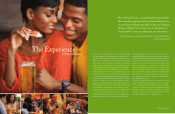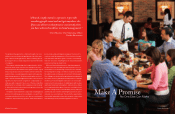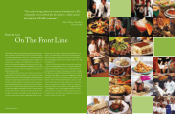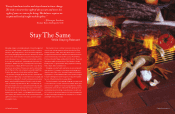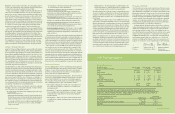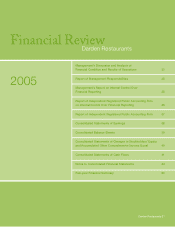Red Lobster 2005 Annual Report Download - page 3
Download and view the complete annual report
Please find page 3 of the 2005 Red Lobster annual report below. You can navigate through the pages in the report by either clicking on the pages listed below, or by using the keyword search tool below to find specific information within the annual report.
Good food and service make a good business, but providing a
total dining experience can transform a good restaurant into a
great brand that endures for generations. The experience is why
Red Lobster is not simply a restaurant, but a trusted name syn-
onymous with seafood in America. The experience is why Olive
Garden is a robust company with 43 consecutive quarters of U.S.
same-restaurant sales growth through the end of fiscal 2005.
The experience includes everything guests encounter, from
the time they first see our restaurant and walk through our doors
until they leave. There is a visual experience. For example, the
island architecture at Bahama Breeze, including a tin roof, rich
woods and wicker furniture, immediately puts you in an island
state of mind. There is also a more subtle, subliminal experience.
Because freshness and cleanliness go hand-in-hand with sea-
food, Red Lobster, like all our restaurants, maintains meticulously
clean restaurants. Olive Garden conveys the spirit of Italian
generosity with unlimited refills on soup, salad and breadsticks.
In short, creating a dining experience is an exercise in
thoughtful details. And those details support the clearly defined
brand vision that is critical to success. Every element – from
food and beverage to décor and service – must be consistent
with the brand and must be monitored to ensure consistency
over time. Smokey Bones conducts an annual brand audit, for
example, in which every guest touch point is evaluated and
examined for consistency with the brand vision, which is to be
known for the friendliness of our people, who serve great-tasting
barbeque and other American favorites in an energetic atmo-
sphere to every guest, every time. Items such as menu design,
artwork on the walls and in-restaurant television programming
are examined to make sure they support the brand. This exer-
cise brings discipline and helps sustain focus and clarity in the
brand management process.
We think about the dining experiences our brands create as a
mosaic – many different, individual pieces that come together
to create one big picture or experience. If pieces are missing
or don’t fit, the picture loses its focus and continuity. As brand
managers, our job is to pay attention to every piece – no matter
how small – to make sure the overall experience is distinct and
memorable and keeps guests coming back for more.
“ Over the last 11 years, casual dining has grown faster
than any other segment in the restaurant industry. Our
research shows that this growth is because we sell more
than great food. Our restaurants are also places to
connect and re-connect with people you care about.”
– Roger Thompson, Senior Vice President, Strategic Marketing
Darden Restaurants
Is What Matters
The Experience
Darden Restaurants 32 Darden Restaurants



